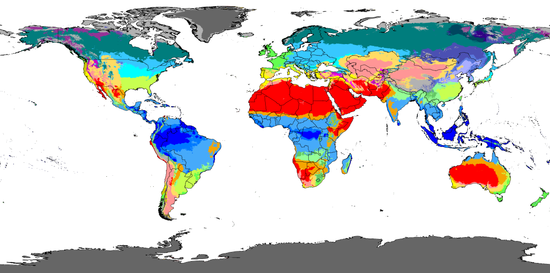Köppen climate classification
climate classification system
The Köppen climate classification is one of the most widely used climate classification systems. It was developed by Wladimir Köppen, a German climatologist, around 1900 (with several further modifications by himself, notably in 1918 and 1936). It is based on the concept that native vegetation is the best expression of climate, thus climate zone boundaries have been selected with vegetation distribution in mind.
System change
- Group A is tropical.[2] The average temperature in the coolest month must be at least 18° C.[2]
- Group B is arid[2] - desert and steppe/semi-arid. The average precipitation must be less than a certain amount that depends on the temperature.
- Group C is mesothermal,[2] the subtropical and temperate climates. The warmest months must have an average greater than 10° C and the coldest month must have a temperature between 0 or -3° C and 18° C. This group includes humid subtropical, Mediterranean, highland, and oceanic.
- Group D is microthermal or continental (hot/warm summers and cold winters) and subarctic (short warm summers and cold winters). The warmest months must have an average greater than 10° C and the coldest months must have an average of less than 0 or -3° C.
- Group E is polar[2] and alpine. The warmest month must have an average temperature less than 10° C.[3]
Related pages change
References change
- ↑ Beck, Hylke E.; Zimmermann, Niklaus E.; McVicar, Tim R.; Vergopolan, Noemi; Berg, Alexis; Wood, Eric F. (30 October 2018). "Present and future Köppen-Geiger climate classification maps at 1-km resolution". Scientific Data. 5: 180214. Bibcode:2018NatSD...580214B. doi:10.1038/sdata.2018.214. ISSN 2052-4463. PMC 6207062. PMID 30375988.
- ↑ 2.0 2.1 2.2 2.3 2.4 Harm J. De Blij; Peter O. Muller; Richard S. Williams Jr., Physical Geography: The Global Environment (New York: Oxford University Press, 2004), p. 71
- ↑ "Koppen climate classification - Description, Map, & Chart". Encyclopedia Britannica.
